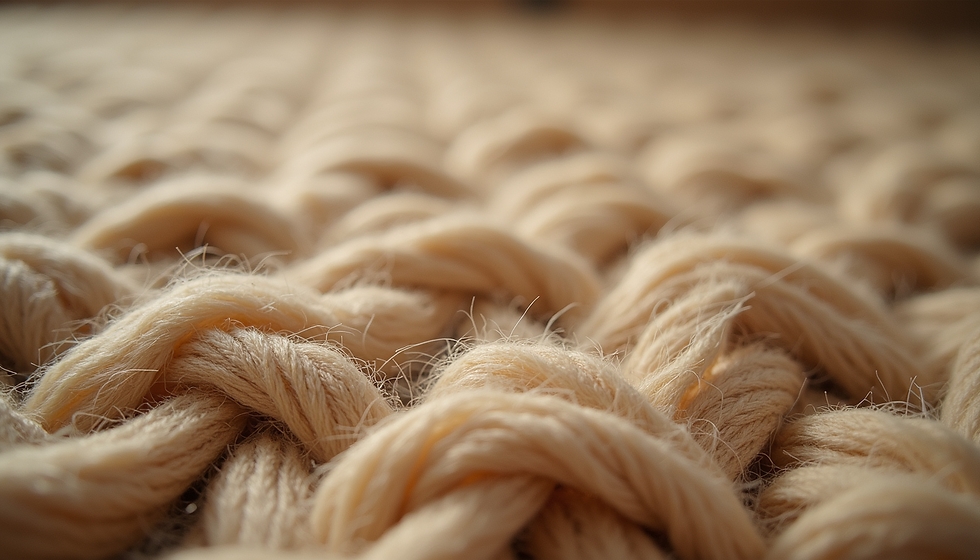How to Successfully Source Quality Rugs for Your Commercial Projects
- Edoburg Pipes
- Jun 4
- 4 min read
Updated: Jun 18
Sourcing the right rugs for commercial projects is not just about finding a stylish design; it demands careful planning and thought. Rugs must blend beauty with functionality, especially in settings like hotels, restaurants, and offices. By paying attention to quality, materials, timelines, and common errors, you can elevate your project and ensure your spaces are inviting and durable.
Evaluating Rug Quality
To kick off the rug sourcing process, focus on evaluating the quality of your options. Quality rugs should not only endure high traffic but also retain their visual appeal over time. Here are specific factors to consider:
Material: The material greatly impacts durability and texture. For instance, wool is naturally resilient and can resist wear and stains effectively. Nylon, on the other hand, is excellent for areas with heavy foot traffic, as it is resistant to fading and abrasion.
Construction: Hand-tufted and hand-knotted rugs generally offer better quality than machine-made ones. High-density pile often indicates greater durability. For example, rugs with a pile height of at least 0.5 inches are usually more cushioned and can withstand daily use without flattening.
Certifications: Look for certifications like RUGMARK or GoodWeave. These labels assure that the rugs were made ethically and meet certain quality standards, enhancing your project’s credibility.
Visiting showrooms to see and feel the rugs can provide valuable insight beyond images or descriptions.
Choosing the Right Materials
Choosing materials is central to balancing aesthetics with function in commercial rugs. Here is a detailed look at some common materials:
Nylon: This material is incredibly durable, with a life expectancy of over 10 years in commercial environments. It resists stains and is easy to clean, making it a practical option for high-traffic areas.
Wool: Often considered the gold standard, wool rugs are not only soft but also naturally stain-resistant. They offer excellent insulation and can last for decades with proper maintenance. In fact, wool rugs can maintain their appearance for over 20 years in commercial settings.
Polyester: This cost-effective choice offers vibrant colors and designs. However, its lifespan can be shorter, especially in heavy use areas, as it may begin to show wear within a few years.
Sisal and Jute: These natural fibers provide a unique look and are sustainable, but they are better suited for low-traffic areas due to their lower durability. Regular cleaning and care are necessary to maintain their appearance.
Understanding these properties helps you pick options that meet your project needs and budget.
Setting Delivery Timelines
Managing project timelines is crucial for success in rug sourcing. Rugs can take longer to arrive than anticipated, especially if they need to be custom-made or shipped internationally. Here are a few strategies for effective timing:
Plan Ahead: Factor in production times, shipping logistics, and possible customs delays. For instance, custom rugs can take up to eight weeks to produce, while standard options may be ready in four weeks.
Communicate with Suppliers: Keep an open dialogue with your suppliers. Regularly ask for updates on lead times and any potential delays. This practice can help prevent last-minute issues.
Buffer Time: Include a safety margin in your delivery timelines. Aim for rugs to arrive at least two weeks before your project completion date, allowing ample time for adjustments.
By creating a detailed timeline, you reduce the risk of installation headaches and help the project move forward smoothly.
Avoiding Sourcing Mistakes
Mistakes in sourcing can lead to unnecessary costs and delays. To navigate pitfalls successfully, consider these approaches:
Do Thorough Research: Knowledge is essential. Investigate different rug suppliers, their reputations, and their experience. Online reviews and testimonials can provide valuable insights.
Sample Selection: Always request samples to assess color, texture, and quality before placing a large order. This step can prevent costly decisions.
Understand Return Policies: Familiarize yourself with suppliers’ return and exchange policies. Knowing these details can protect your project if the rugs do not meet your expectations.
Budget Considerations: Consider investing in better-quality rugs. Although the initial cost may be higher, quality rugs can greatly reduce replacement expenses and maintenance in the long run.
Implementing these strategies can significantly minimize sourcing errors and facilitate a smooth project completion.
Building Relationships with Suppliers
Creating strong relationships with your rug suppliers can have long-term benefits. Good partnerships lead to:
Better Pricing: Consistent orders often give you access to discounts or exclusive offers. For example, loyal clients may save up to 15% on larger orders.
Priority Access: Suppliers frequently prioritize orders for established clients, ensuring quicker turnaround times for future projects.
Support and Guidance: An experienced supplier can offer vital advice and insights based on their extensive industry knowledge, helping you make informed sourcing decisions.
By maintaining regular communication and fostering positive relationships, you transform your sourcing process into a collaborative effort.

Final Thoughts
Sourcing rugs for commercial projects requires careful consideration and strategic planning. By properly evaluating quality, selecting the right materials, setting realistic delivery timelines, and avoiding common mistakes, you can enhance your project outcomes significantly.
Furthermore, nurturing relationships with suppliers can lead to advantages that go beyond the immediate scope of your projects. Keep these guidelines in mind as you embark on your next commercial rug venture, and you will achieve visually stunning and functional results that stand up to the rigors of high-traffic environments.
With thoughtful sourcing practices, you create inviting and lasting spaces that leave a memorable impression.






Comments